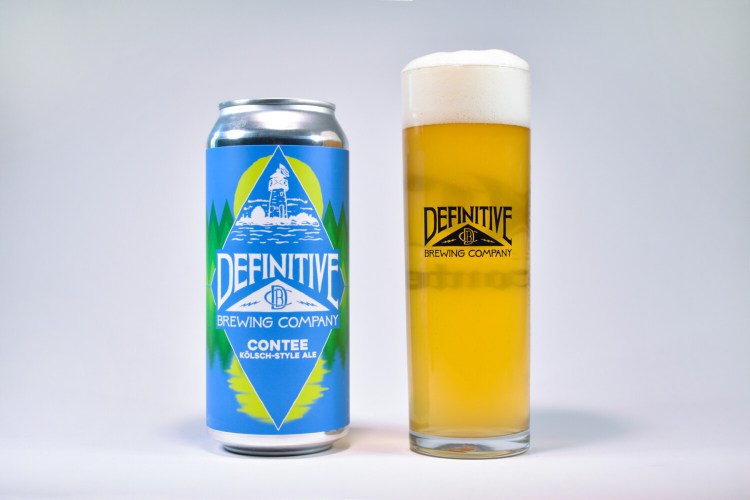It might be lazy to say that Germans love rules, but it wouldn’t necessarily be wrong. It is ironic, then, that a beer born of so many rules – the Kölsch – would turn out to be one of the most easy-going and approachable styles around.
Kölsch is a style that has inspired a good many beers in Portland: not every brewery makes one, but most do (and sometimes two or three versions). Definitive’s Contee is a popular one. Pale straw in color, it has a mild, grainy nose and an effervescent, light body. It’s biscuity, with a touch of lemon, and a clean finish. At 4.6% ABV, it is a pleasant drinker for a sunny summer day – and a good representation of the style.
But as the can will tell you, Contee is not a Kölsch; rather, it is a “Kölsch-style ale” – a distinction that is likely lost on some American drinkers, but not those Germans with their rules. To truly be “Kölsch,” the beer must meet a number of criteria established by the Kölsch Konvention of 1986. (incidentally, the same year that D.L. Geary’s Brewing Company, Portland’s first craft brewery, opened at Riverside.) But the story of Kölsch is a longer one than that.
Though brewers in Cologne (Köln in German) have been making beer since the Middle Ages, “Kölsch” as we know it wasn’t developed until the late 19th century, when pale lager began arriving from Bohemia. Köln’s concerned brewers developed their own pale beer in response. Like Bohemian pilsner, Kölsch was golden and hoppy; unlike pilsner, it used a top-fermenting ale yeast, which imparts a subtle fruitiness to the beer. With the advent of this new style, the Bohemian pilsner-tide was checked.
Nearly a century later, at the 1986 Kölsch Konvention, the city’s brewers codified what an authentic Kölsch is: “a light-colored, highly fermented, strongly hopped, bright, top-fermented Vollbier” (a “Vollbier” being a regular beer – that is, not particularly strong or light in alcohol). It had to be brewed within 50 kilometers of Köln. Authentic Kölsch also must adhere to the strictures of the “Reinheitsgebot” (or “Purity Law”) that limits the ingredients of beer to barley, hops, water and yeast. Kölsch even has prescribed glassware – the iconic 200 milliliters “stange” glass.
History thus tells us that the Kölsch is something like a Bohemian pilsner (and a distant cousin of the American cream ale, which too was an attempt to replicate the crisp drinkability of the lager, but in ale form). But the glass tells us a lot too.
A stange is narrow and tall (“stange” means “pole” in German), and its form highlights the Kölsch’s brilliant clarity and effervescent character, its tiny bubbles animating the glass. At 200 milliliters, it is also rather small. In a traditional setting, the table is being continually served, with 10 or more glasses brought out on a tray known as a “kranz” (“wreath,” in English). And so, the beer is always fresh in the glass, amplifying the delicate brightness of the style.
Don’t expect a franz of stangen if you order a Kölsch-style ale in Portland — though you may get it in a supersized version of the “pole.” While you can get authentic imported Kölsch from the likes of Reissdorf, Gaffel, Sünner and Früh, it certainly won’t express the youthful vigor of the real deal (though Novare Res often has one on draft). But local interpretations abound that suggest some of the range that the style can possess in the hands of Portland’s brewers.
Like Definitive’s Contee, Austin Street’s Kölsch (5%) is rather restrained. Brewed with pilsner malt, a small amount of malted wheat (which helps add head), and Noble hops, it combines notes of honey and straw, with a subtle fruitiness typical of the style.
Restraint is not the modus operandi of Bunker’s Boogie Board Stuntz — a collaboration with Brooklyn’s Other Half — whose brash assertive hoppiness pushes the limits of the style. Hopped with Mosaic and Mandarina Bavaria, it pops with grapefruit and lemon atop a light body, and finishes crisply – and at just 4.8%.

Mast Landing’s Rooftops has fresh grainy aromas, a light breadiness and a hint of citrus. Photo Courtesy of Mast Landing
Drinking different versions side-by-side is a pleasurable and edifying exercise. Mast Landing’s tasting rooms, in Westbrook and Freeport, are currently featuring both of their Kölsch-styles ales. Everybody/Everywhere (4.8%) is an easy-drinking, balanced beer that is a little grainy, a little fruity and a little sweet. The name itself “speaks to the accessibility of the style,” according to Gene Buonaccorsi, the brewery’s Director of Marketing, “as well as the growing geographic ubiquity of Kölsch as American brewers, European brewers, and beyond work it into their repertoire.” Rooftops (5.2%) is more malt-forward, with fresh grainy aromas, a light breadiness and a touch of citrusy zest. It is a beer that “reflects a feeling, a moment, an energy – the emotional space of enjoying a refreshing beer while watching the sun go down,” Buonaccorsi says.
And this is really the essence of Kölsch: its easy drinkability as the unassuming centerpiece to a session with friends. We have the fussy brewers of Cologne – and all their rules – to thank for that. But if you call it Kölsch, watch out for the Ordnungsamt (“Office for Public Order”), who do not look kindly on minor violations.
Ben Lisle is an assistant professor of American Studies at Colby College. He lives among the breweries in Portland’s East Bayside, where he writes about cultural history, urban geography, and craft beer culture. Reach him on Twitter at @bdlisle.
Send questions/comments to the editors.



Comments are no longer available on this story